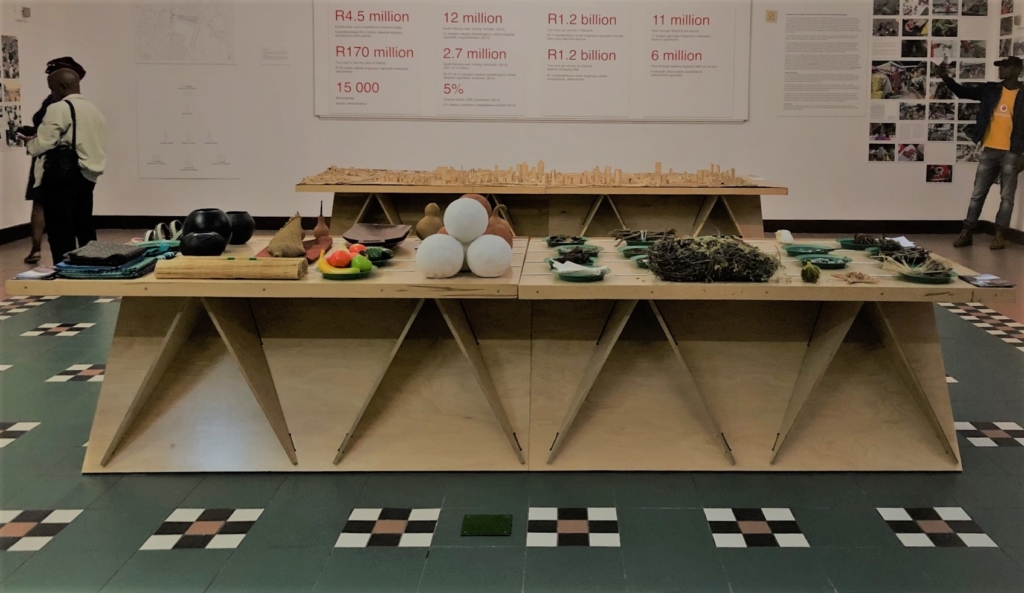An exhibition on Durban’s contribution to city making, that also celebrates the diverse livelihoods represented by the markets which form a substantial part of Durban’s local economy.
The exhibition Enabling Structures: Markets of Warwick Junction by designworkshop:sa and Asiye eTafuleni, was originally showcased at the 2016 International Architecture Exhibition Biennale in Venice, Italy, and viewed by over 270,000 visitors. This exhibition came home to Durban and opened in October 2019.
EThekwini Municipality’s Durban Local History Museums in partnership with City Architects, hosted a launch event for this exhibition presented at the Old Court House Museum. The event was ushered in by a speech from Andrew Makin, a Partner at designworkshop. Designworkshop is an architectural practice that was invited to participate in the 2016 International Architecture Exhibition Biennale, specifically to showcase the innovative 1996 eThekwini Municipality commission design for the Warwick Junction traditional herb and medicine market. Makin shared how this collaborative urban intervention is an exemplary example of a relatively low capital investment that has yielded exponential return (with an estimate annual turnover of R1.2bn in Warwick Junction), compared to regional shopping mall developments. Motivating how future investments in the City could be shaped by the example of Warwick.
“The informal economy is not something to be swept away, it is the future”
Andrew Makin, designworkshop
“The lessons of Warwick are that it is very likely to be the most potent mechanism to achieve radical reduction in poverty, joblessness and wealth disparity”
Andrew Makin, designworkshop
Tobias Mkhize, a former municipal Environmental Health Department Official, also delivered a speech at the opening. Mkhize recalled stories from his time involved in Warwick Junction that revealed the cultural responsiveness of the area. After many important acknowledgements to all those who made the broader project possible, guests were invited to view the exhibition.
If you have ever experienced the markets of Warwick Junction it is hard to comprehend how one could reduce the vibrant, functioning public spaces and markets into a single room. However, it is something to behold to experience Warwick through a different lens. The exhibition includes; historical context and maps of Warwick Junction, bold statements of Warwick’s social and economic impact, stories and images reflecting the livelihoods of informal workers’ that uphold the thriving economy, sketches of the of the bridge connecting the traditional herb and medicine market, intricate and impressive models of Warwick and the CBD and the final touch was an array of products from the traditional herb and medicine market.

Enabling Structures Exhibition, Durban’s Old Court House Museum. 
Richard Dobson and Patric Ndlovu from AeT with Thula Mdluli, Secretary of the traditional herb and medicine market.

Intricate model of the pedestrian bridge linking to the herb market, Warwick Junction. 
Xoli, a traditional healer, viewing her story and pictures that contribute to a selection of stories of informal workers from Warwick Junction.

The exhibition emphasizes the significance of Warwick as an essential urban node and how the bridge that physically linked Warwick to the dominant formal economy catalysed a number of interventions that have transformed Warwick, and the broader inclusion of informal trade in the City.
Unfortunately, from being a City that had an exemplary approach to informality, it has retreated into defensiveness and conservatism. This is evidenced in the lack of investment in infrastructure following the initial work in Warwick Junction. There is an absence of appreciating that the informal economy could be a pillar of the City’s economic development strategy – there is adequate evidence that there is mutual benefit to everyone. Embracing informality is the greatest opportunity to address both cultural and economic transformation.




